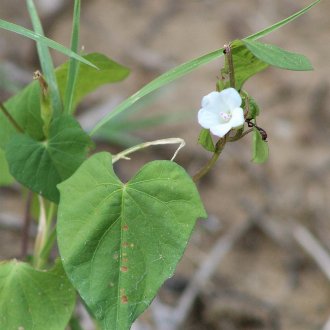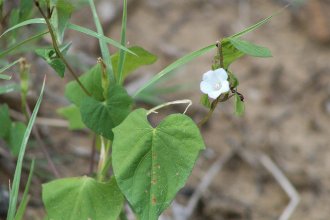Small White Morning-Glory (Ipomoea lacunosa L.)
Also known as Whitestar.
↑Summary
An annual vine with smaller flowers than most morning-glories.
↑Range - Expand
| Legend | Color |
| Native | |
| Native or Not Present | |
| Expanded or Not Present | |
| Native or Expanded or Not Present | |
| Introduced or Not Present | |
| Expanded |
This map is based on our research. We have checked its accuracy to Level 3 ecoregions. Although this plant occurs somewhere in each of these regions, it may only occur in a small part of some or all of them.
This plant is sometimes cultivated and can escape cultivation, but it is also rather weedy and spreads on its own. We marked the new eastern populations as expanded because they are close to its native range, but the California population introduced as it is separated by a great distance.
↑Habitat
Found in sunny habitats with disturbed ground. Natural habitats are mostly in moister bottomland areas, and include mesic prairies, riverbanks, marshes, swamps, and lakeshores. Frequently found in anthropogenic habitats, including in abandoned fields, along roadsides and railroads, and in waste areas. Also found as a weed in cultivated cropland, including cotton, corn, and soybeans.
In the north of its range it is mostly restricted to anthropogenic habitats, but also tolerates drier conditions, whereas in the south it is more restricted to moister habitats but less restricted to anthropogenic habitats and also occurs in more wild areas.
Tolerates a range of soil conditions including loam, clay, and gravel. Can survive in sandy soils if there is sufficient moisture, such as in sandbars in riverbanks.
We could not find information on this species' relationship to fire, but it likely benefits from fire due to its ability to colonize disturbed ground where competing vegetation has been removed. However it also thrives in habitats protected from fire, due to moisture and/or human fire suppression.
↑Life Cycle
This species is an annual vine. Seeds germinate over a wide period of time throughout the growing season, often in response to disturbance. Seedlings quickly establish a taproot and maintain this root structure during their whole lifespan. The taproot of this species tends to be narrower than other Ipomoea sp..
Growth is rapid, even compared to other plants of the Ipomoea genus. Plants branch readily, often extending in many directions at once. The twining habit of vines allow them to readily climb narrow-diameter vegetation, as well as anthropogenic structures such as chain-link fences, but they cannot easily climb walls or larger-diameter tree trunks. Growth is often sprawling, extending horizontally over exposed ground or low-lying vegetation. Plants eventually reach lengths of 3-7 feet, sometimes up to 10 feet on favorable sites, and individual plants may cover a large area if they are successful in multiple directions.
Flowering typically begins mid-summer and often continues well into fall, with flowering times varying considerably based on local conditions, often continuing into December in the warmest parts of its range, but ending considerably earlier in areas subjected to earlier frosts. Plants often produce an abundant flush of flowers, and then continue flowering sporadically until plants are killed by frost. Plants are sensitive to frost and often the whole plant is killed by the first hard frost, with parts of it damaged even by light frost. Plants are self-fertile, facilitating the establishment of new populations on sites where one isolated plant gets established. Although the flowers can also cross-pollinate, this species shows a stronger tendency towards selfing than most Ipomoea, which is reflected in its less-showy flowers.
On a favorable site, and for plants germinating sufficiently early in the season, plants can produce up to 10,000 seeds. Seed production is less on harsher sites, when other vegetation is competitive, or when plants germinated later in the season. The seeds are relatively large and dispersed primarily by gravity, with the aid of the plant's vining habit that can cause many of them to fall several feet from where the original seed took root.
Seeds have a long period of dormancy, and form a long-term seed bank, and have been reported as viable for as long as 39 years. Few germinate in the first year following seedfall.
↑Faunal Associations
The foliage is usually avoided by mammals due to its toxicity and unpleasant odor. The seeds are eaten to some degree by some larger birds, but are not usually a preferred food source as they are also somewhat toxic.
The flowers attract primarily long-tongued bees, including bumblebees, small carpenter bees (Ceratina sp.), the mallow bee (Melitoma taurea) which prefers man of the earth (Ipomoea pandurata) but also visits this species, and the eastern curcubit bee Peponapis pruinosa, and Cemolobus ipomoea (Morning Glory Bee), which prefers squash and gourds. This species is less attractive to bumblebees than Ipomoea sp. with larger, purple flowers. In general, this species relies less on pollinators and more on self-fertilization, and probably provides less value to pollinators than other members of its genus.
There is little information on insects that feed on this plant specifically. The caterpillars of the morning-glory plume moth (Emmelina monodictyla) consume the leaves, as do several species of tortoise beetles (Cassidinae subfamily). There are numerous other lepidoptera species that eat other Ipomoea species in its range, but we could not find reports of other insects eating this species specifically.
The primary benefit of this plant to wildlife is indirect, in its ability to germinate at any time during the growing season and quickly cover exposed ground following a disturbance that removes vegetation.
↑Control
This species is considered a noxious weed in parts of its native range, due to its impact on commercial agriculture, where it can drastically reduce crop yields if established in sufficient numbers. It also has potential to become invasive when introduced to new areas.
Because of the large seed production and long dormancy of seeds, it may not be possible to remove it once it is introduced to an area, so control efforts usually focus on reduction. It is also important to avoid introducing it to new areas by avoiding moving soil from areas where it is present to areas where it is not.
Plants are highly susceptible to herbicide, with most herbicides effectively controlling it, except for Quinclorac and S-metolachlor fb prosulfuron, which are less effective and usually leave some plants, and glyphosate, which this plant has evolved resistance to, probably because it is so widely used. However, herbicide use, if effective in the short-term, is not sustainable to control this species long-term because a few individuals nearly always survive treatments, and thus it quickly evolves resistance. A more sustainable approach requires fundamental modification of agricultural practices to reduce the soil disturbance and high-light conditions that favor its establishment.
Because it often occurs as isolated plants, manual control can be highly effective when its numbers are small and/or when it establishes on a new site, but it is key to find where the plant has rooted, as killing a smaller branch will do little to harm the plant. Uprooting the plant, or for a low-effort approach, snipping it off at the base, will kill all the plant's upper parts. To result in long-term reduction, plants must be killed before they produce seed.
When this plant is already present in large numbers, the best control approach is to ensure coverage of soil and avoid the vegetation removal and soil disturbance that favors its germination and growth. It cannot germinate with heavy competition from ground-level vegetation, nor can it survive when sufficiently shaded by a canopy of trees.
↑Uses
This species is occasionally cultivated, less so than other species of its family, owing to its less-showy flowers.
It has also been used in land reclamation and phytoremediation, particularly of land contaminated by lead, as it is unusually tolerant of lead relative to other plants.
↑Related Plants
This species is closely related to tievine (Ipomoea cordatotriloba), and hybridizes with it to form hybrid morning-glory (Ipomoea ×leucantha). There is evidence that hybrids are fertile and there is bidirectional gene flow between this species and I. cordatotriloba. Although the species are morphologically distinct and usually easily distinguished, genetic analyses show them to be very similar on a genetic level. There is some uncertainty as to how to best classify these species.
Outside of these, there are numerous other Ipomoea sp. overlapping with this one in range, including native ones, ones introduced or expanded from south and central America, and from Asia as well.
↑Links & External Resources
• Ipomoea lacunosa (Small White Morning Glory) | Illinois Wildflowers (About This Site)
• Ipomoea lacunosa (whitestar) | USDA PLANTS Database (About This Site)
• Ipomoea lacunosa | Go Botany (About This Site)
• White Morning-Glory | iNaturalist (About This Site)
• Ipomoea lacunosa | Biota of North America Project (BONAP) (About This Site)
• Ipomoea lacunosa | NatureServe Explorer (About This Site)
• Ipomoea lacunosa | Missouri Plants (About This Site)
• Small White Morning-glory | Maryland Biodiversity Project (About This Site)
• Ipomoea lacunosa L. (Small White Morning Glory) | Digital Atlas of the Virginia Flora (About This Site)




